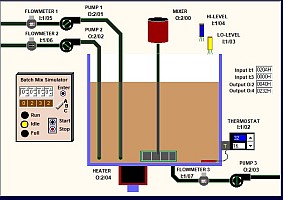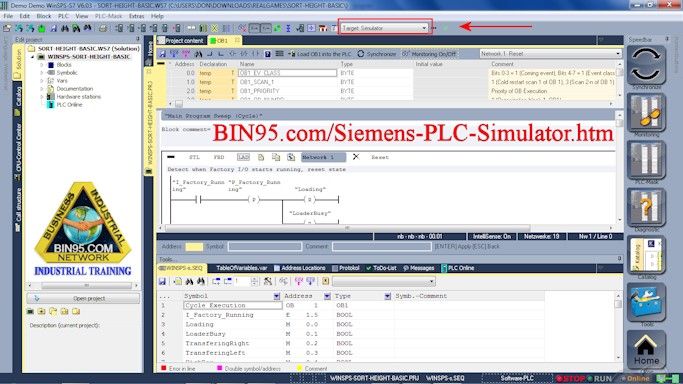2024 Automation Technician Training Trends
- Home >
- articles >
- automation >
- automation technician training
Including Trends In PLC Programming Languages.
You may want to browse the PLC automation trends using the menu below or scroll to read the entire article.
SECTIONS
The 2024 PLC automation trends are essential for acclimating automation technician training students. Newcomers to the control workplace will also find this article helpful. The author wrote this article to help new automation and control technicians. It aims to give them a competitive advantage in the automation technician job market. It may help with technician certification on automated systems. But that is not the intent.
PLC programming languages are a crucial aspect of automation technician training. We start with trends in PLC programming languages. They are vital to the automation and controls technician training curriculum.
Read on for insight into the automation technician's world.
PLC Programming Languages Trends
Below are trends in popular PLC programming languages only. Other programming automation trends for devices, such as HMI, CNCs, etc., will be a story for another day.
Structured Text Programming (ST)

Structured Text programming (ST) is a good example. A trend or popularity does not necessarily mean it is the best practice. For instance, SoftLogic was once popular. Another example is using the IF/THEM PLC method instead of a shorthand, non-retentive assignment "[:=]". The shorthand is safer and easier if the PLC brand offers that functionality.
The process and manufacturing industries value reliability. They want to cut downtime costs. These are the best practices. So, they prefer Ladder Logic. Automation programming students often prefer ST programming. One reason may be that they are already familiar with other text-based languages. However, it is more complex and costly for their customers, the end-users, to work with for the next ten years.
The best practice is to program mainly in ladder logic. Use ST for large data handling and algorithms.
Function Block Programming:
Function Block programming is not so much a trend as Structured Text (ST) programming is. But if it were, many reasons ST wouldn't be applicable would also apply to FB programming.
Modular programming (reusable code blocks) is the best practice for a programmer. Each function may also have hidden ladder logic or Structured Text. The end user (plant maintenance and engineering) uses the graphical function block, not their internal code.
FB programming is a GUI. It makes it easier for automation control users to follow. But it has other barriers. Difficulty in accessing code within, and the methods vary between PLC vendors.
PLC Function Block Diagram (FBD) programming is most popular in the pharmaceutical industry, as well as in the oil and gas industries.
Ladder Logic Programming:
Ladder Logic Simulator
STARTSTOPRUN
───┤ ├─┬─┤/├─────────────( )──
│
RUN │
───┤ ├─┘
Power can flow through contact from left to right to energize the output coil on the far right.
Boolean Equation
Y = (A + Y1)(B)
RUN = (START OR RUN-1) AND (NOT STOP)
Java Script
if ((START || RUN) && !STOP) {RUN = true;}
else {RUN = false;}
Mnemonic Codes
LOD START
OR RUN
AND NOT STOP
OUT RUN

Ladder Logic programming is still the top PLC programming language. People often call the Ladder Logic programming language "LD" (for ladder diagram). Its popularity holds despite Structured Text's rise among students and industry newcomers. Two main factors make Ladder Logic the most used PLC language. Instruction List (IL) mnemonic code language is the least used.
- PLC reliability reduces the need to upgrade and change the PLC programming languages.
- The end-user focuses on downtime reduction.
- Their in-house maintenance and engineering team knows ladder logic. That familiarity cuts the time for troubleshooting and minor program changes.
- Working with the other PLC programming languages can be challenging. They are complex and prone to human error. The related hardware and software upgrades may be complex, too.
Sequential Function Charts (SFC):
Sequential Function Charts (SFC) look like FBDs. The process controls dictate the order of the steps. So, the screen displays the sequential function blocks (steps) in that order. SFC PLC programming is more common in process industries like oil and gas. Like structured text programming, only use SFC programming if the application warrants it. One example may be if writing in Ladder Logic requires many SQL (sequential load) instructions. You would create an SFC subroutine to support the main Ladder Logic program.
PLC Automation Statistics
PLC Sales:
PLC and automation usage statistics also help to identify 2024 PLC Trends.
- The global PLC market for 2024 is $14 billion and continues its 5% annual growth to reach $15.5 billion in 2026.
- The 2024 industrial automation market is about $181.6 billion. It will grow by 9% a year.
- While North America has a large portion of the global PLC market, Asia has the largest market.
Automation Technician Jobs:
Automation control applications grow more complex each year. As systems get more complicated, the demand for automation controls technicians rises. If you Googled the job growth of "automation technicians", don't panic. You might see the headline below.
"Automation engineering technician demand is projected to decline 3% from 2018 to 2028."
Always consider the statistical numbers in context. Otherwise, they are useless and may even be harmful. The example above only measures employers who chose the "Automation Engineering Technician" title. The reported decline is not for "Automation Technician", a different job title.
Also, a key point is that employers choose their job titles. They can even create a new one. There is no international or global job title definition that all adhere to. The employer may call an automation technician a "maintenance," "PLC," or "electrical" technician." Some may call them a "maintenance mechanic." But they work on PLCs and other automation controls.
So, with statistics, context is everything!
Jobs for automation technicians will grow 5-10% a year. Depending on the economy and other factors.
PLC Brand Popularity:

PLC's global market share can best gauge PLC's brand popularity. Also, consider geographical region and industry. They affect PLC's brand popularity. Another key factor in choosing a PLC vendor is standardization. A manufacturer prefers the brand that currently dominates its facility's operations.
Below is a list of the most popular PLC brands by global market share (with notes about other segments).
- Siemens (Most used in Europe.)
- Rockwell Automation (Most used in North America.)
- Mitsubishi (Most used in Asia)
- Schneider (Popular in the energy industry.)
- Omron (Most used in Japanese automotive.)
- GE / Emerson (Strong in energy and mining sectors.)
- Keyence
- ABB
- Bosch Rexroth
- Hitachi
Programmable Logic Controller (PLC) Trends for 2024
Automation control improvements to speed up and increase data flow between producers and consumers. Industry 4.0 is driving a lot of this trend. That summarizes the PLC and PAC trends for 2024.
1. Computing Integration: PLCs will develop their data processing capabilities. Vendors will speed up data flow and decisions by processing data closer to its source.
2. Cybersecurity Enhancements: PLC vendors will focus on cybersecurity as networked systems grow. Security is vital for protecting industrial control systems from ever-growing cyber threats.
3. IIoT Integration: Automation designers will use more Industrial Internet of Things (IIoT) devices. Increased IIoT usage will further enhance data collection, analysis, and remote monitoring capabilities. Siemens and Mitsubishi have IIoT-ready PLCs. Also, other vendors will release theirs.
4. AI and Machine Learning Integration: Vendors are exploring AI to improve PLCs. They want to use AI for predictive maintenance, process optimization, and fault detection. As Edge AI/ML matures, deployments will experience a substantial increase in 2024.
5. Improved Diagnostics: More powerful PLCs will enable remote troubleshooting and diagnostics. Increased diagnostics further reduce downtime.
6. Modular, Scalable Designs: PLCs will trend toward smaller, modular designs. This combination will enable easier integration and expansion.
7. Cloud Connectivity: PLCs will offer more cloud connectivity options. Doing so will enable data sharing and access to powerful cloud-based analytics. Cybersecurity features and improvements will be the areas to watch.
8. Focus on User Experience: Tools simplify PLC setup, configuration, and maintenance. They concentrate on designs that are easy to use and understand. Designing PLC software for its future maintainer gets less attention than it deserves. Equipment designers continue to choose less end-user-friendly PLC programming languages. They are continuing to write new programs in ST instead of Ladder Logic. It will continue to be so unless their customers request Ladder Logic.
9. Enhanced Safety Features: The goal is to add advanced safety features to PLCs. Features to better protect workers and assets in industrial environments. Cybersecurity is critical to safety programs as more equipment connects to the cloud [Internet].
PLC Simulator Trends
Many PLC simulators exist. Sometimes, PLC vendor software contains simulators/emulators. A PLC simulator mimics the PLC software. Automation and controls technicians use a PLC simulator for training. It also lets users test automation programming ideas. An emulator mimics both the software and hardware.
See the examples of Industrial Training Simulator Software. They will show you the uses of PLC simulation training apps.
The major PLC vendors usually provide a PLC emulator for their brand. It lets the designer test their PLC program on specific PLC models and settings. People in the industry often confuse "PLC simulator" with "PLC emulator." They are two different types of software. People confuse the two terms, treating them as synonyms.
PLC Simulator Definition: A simulator is a software tool. It mimics a real system or device. It enables users to rehearse tasks through simulation, eliminating equipment needs. A PLC simulator mimics the PLC software. It provides a generic hardware platform for training and testing automation programming ideas.
PLC Simulator Definition:
A simulator is a software tool. It mimics a real system or device. It enables users to rehearse tasks through simulation, eliminating equipment needs. A PLC simulator mimics the PLC software. It provides a generic hardware platform for training and testing automation programming ideas.
PLC Emulator Definition:
An emulator is a tool or app. It replicates the software and hardware of a specific system or device. A PLC emulator mimics both PLC software and hardware. It lets designers test PLC programs on specific PLC models and settings.
Difference Between PLC Simulator and Emulator:
Some PLC emulators also allow IDE access. IDE capabilities further set them apart from PLC simulator software. You can use the emulator as a simulation tool, not vice versa.
It can get confusing, like in the Factory I/O simulator bundle. That example is a PLC simulator. It connects through IDE to a PLC emulator. The Factory I/O simulator simulates factory equipment and robots. It uses the Siemens emulator to run PLC programs. It controls machines made in factory simulator software. You can buy IDEs for many PLC brands to support factory simulator software. A testing and training tool rolled into one software bundle.
Another difference is that a PLC emulator can use multiple PLC languages. A simulator will only support one programming language, usually Ladder Logic.
PLC Emulator Software:
Rockwell - Studio 5000 Logix Emulate (over $8k)
Siemens - WinSPS-S7 + Factory I/O ($189)
Multiple Brands - CODESYS V3 (free + $32per PLC brand)
PLC Simulator Software:
LogixPro ($38, w/course $149)
PLC Simulator Online (Free)
Rockwell's CCW (Free editor, simulator, emulator)
AD's do-more Designer (Free)
Summary:
Awareness of the latest PLC automation trends is vital for automation technician training. Aspiring automation techs must understand PLC languages. These include Ladder Logic, Structured Text, and Function Block.
Use PLC simulators and emulators as training tools. This can provide significant advantages for students in developing their automation programming skills. Automation controls technician training programs should raise student awareness of these trends. This will better prepare them for the changing world of industrial automation control.
This article focuses on PLC. Also, learn about trends in other programmable automation technologies, like PAC, HMI, SCADA, DCS, and CNC. This will likely be helpful.
Related Courses:
Automation Technician Training Bundle
Related Article:
PLC Technician Training Certification
Electromagnetic Induction Applications for the Instrumentation Technician
Instrumentation and Process Control Training
Electrical and Instrumentation Technicians - Troubleshooting FAQ



